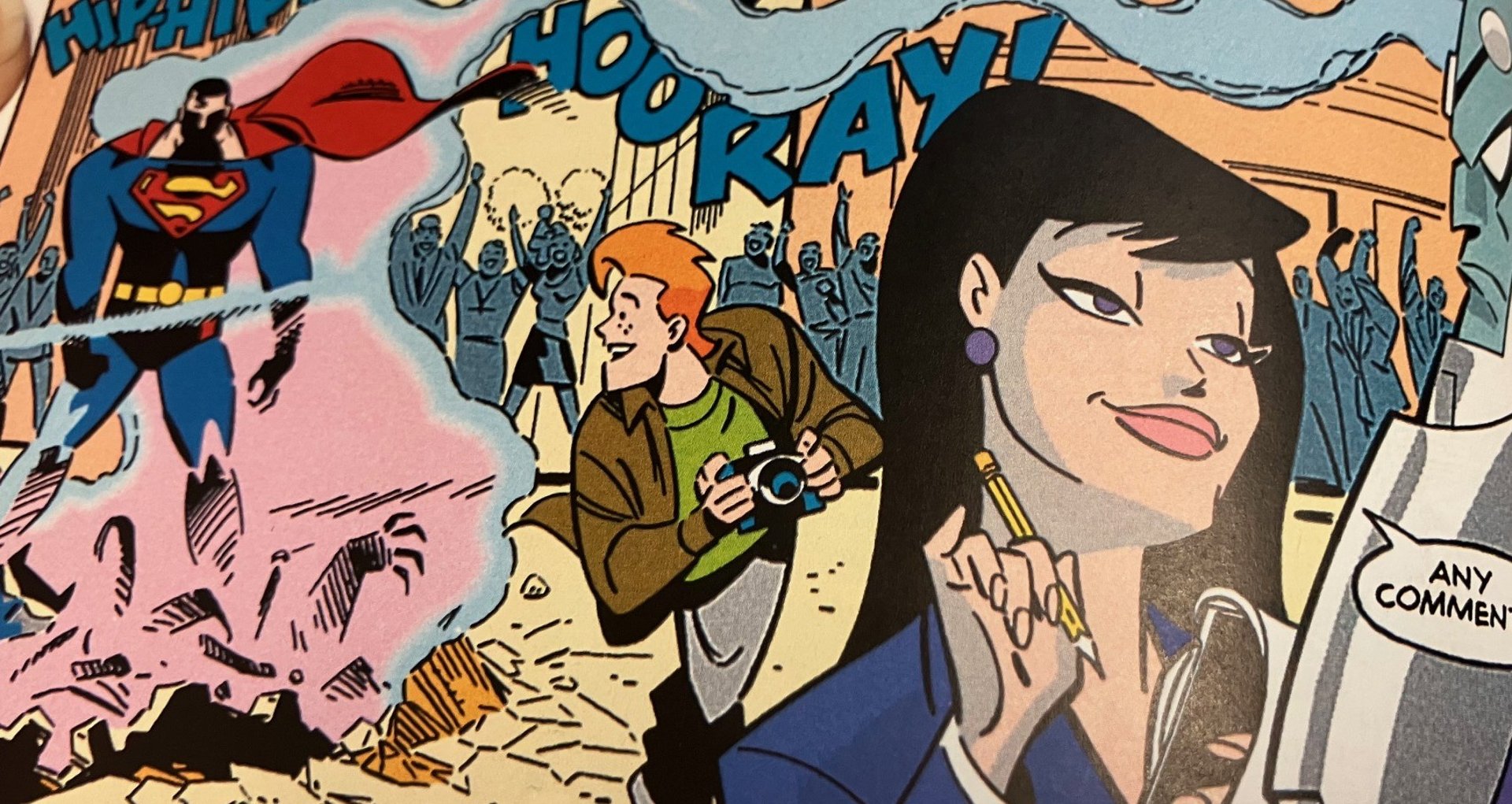
Superman Adventures Compendium One - An Underwhelming Collection of Superman's Most Underrated but Fabulous Tales
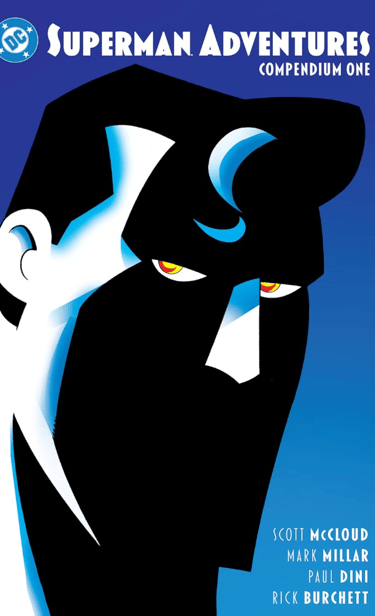

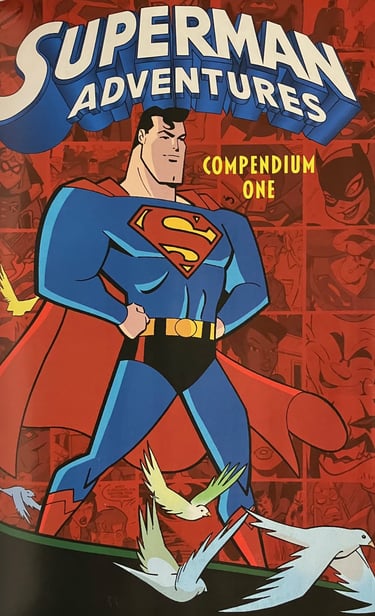

Being Superman doesn’t mean being first, apparently. Despite being the first the Superhero—the archetypal template from which all other super-costumed dudes originate—poor Supes is commonly usurped by his derivatives and copycats. Characters like Omniman, Homelander, and One-Punch Man all contain an edge or intrigue that Superman supposedly lacks. And then there’s Batman, the alien’s alleged opposite who, despite the cowl and the scowls, is still said to have a heart of gold.
In fact, more than Lex Luther or Brainiac or some hypothetical fight against Japan’s legendary Goku, Batman is Superman’s greatest nemesis—in the real world, that is. Despite battling gods and rescuing cats alike, the Man in Blue is regularly overshadowed by his pointy-eared counterpart. Apparently, dressing like a grimacing bat is cooler than benching buildings or flying to the moon.
And in the ‘90s, that unfortunate balance was at its climax. Bats was enjoying a popular revival at both the box office and in the home, with the latter’s Batman: The Animated Series defining the character for an entirely new generation of fans. The cartoon show was so good, in fact, that it received a comic book sister series in The Batman Adventures, a monthly comic that cribbed the styles and themes of the show while spinning brand new tales. It, also, was surprisingly good.
How does Superman fit into all of this? Well, thanks to Batman’s animated excellence, a Superman show was also developed. But, despite being an inspired, posh production, it never quite garnered the same accolades of its grimmer predecessor. Indeed, the show’s 54 episodes is no match for Bat’s 85. Similarly, when Superman got his own comic book adaptation, the similarly named Superman Adventures, it lasted a mere 66 issues compared to Batman Adventure’s (approximately) 143. The Man of Steel, it seems, is always late to the race, always second place.
And it gets even worse. Despite The Batman Adventures receiving a beautiful hardback omnibus in 2023, Superman wouldn’t receive his own compendium until 2025–a thick but flimsy paperback rinsed of any history, of insight…of delight. Superman Adventures: The Compendium features no interviews with the original writers and artists, no contextual showcase concerning the cartoon on which it is based. And most egregious, no foreword or essay praising a series that, for as much as it was (and continues to be) overlooked, it sports some of the most fun, most outrageous, most spirited takes on Superman and his world ever committed to paper.
More than just a frivolous extension to an already underappreciated cartoon, Superman Adventures often trumped its source material—often surpassed even the mainline Superman comics—with its tales of derring-do and uninhibited optimism. Superman Adventures understood its hero as the ideal man and romanticized his adopted country as a noble, virtuous land: The American Way and American Exceptionalism all embodied, quite handedly, by the legendary hero.
This Superman is smart, determined, and brave. And, in many ways, so were his writers who dared to get fancy and whimsical with all the wild dangers this “invincible” man constantly confronted. And, moreover, they were courageous. Why does Superman never give up? Why does he persist in his pursuit for truth, his never-ending crusade to "save-the-day"?
Because, more than being a proud Kryptonian or Earthling, Superman is a proud American—a citizen grateful for the surrogate land he now represents. More than alien, more than man, he’s a symbol…the manly manifestation of the red, white, and blue. Superman Adventures, in other words, isn’t embarrassed by its optimistic boy scout or his unapologetic patriotism. Superman is freedom and virtue given flesh and a costume.
And that’s a distinction even its illustrious cartoon show would sometimes forget.
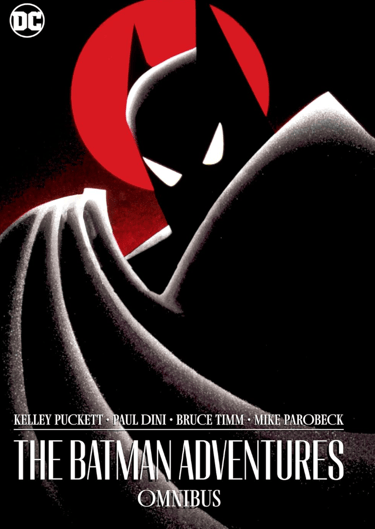

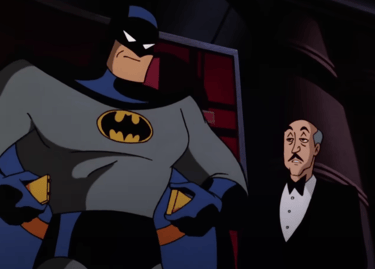

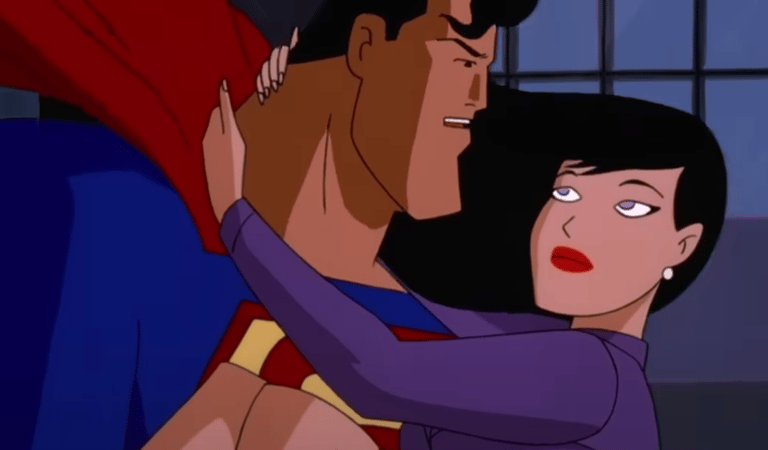

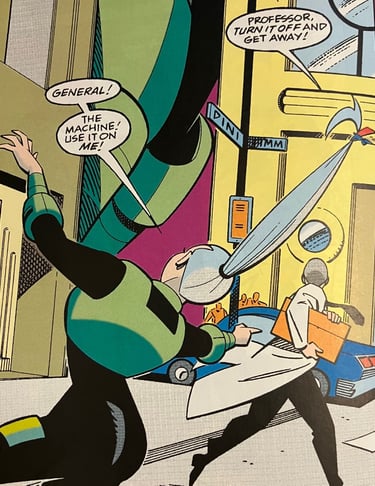

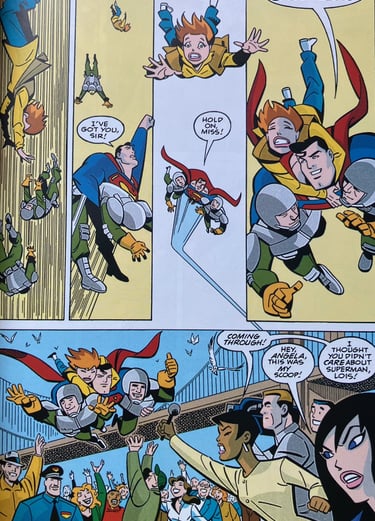

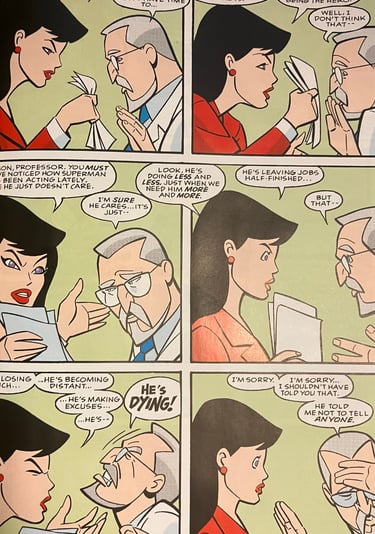

Superman, despite his assumed prestige, often gets slighted in favor of Batman and certain "flavor-of-the-week" heroes. And it's no different here: Superman Adventures is an excellent series that DC could be barely bothered with, providing a slapdash omnibus without interviews, features, or even a hardback cover. Worse, the bland, nondescript cover art does little to convey the creativity, the optimism, the pure vim and whim that lies within the book's pages.
Indeed, Batman: The Animated Series came first, spawning its hand-drawn sister series The Batman Adventures. Eventually, Superman would get his own animated show. And from that, get the similar comic book spin-off known as Superman Adventures.
Superman Adventures: What it is...and Why it Matters
Superman: The Animated Series is a fine series in its own right. But even its biggest fans often forgot the adjoining comic which, in truth, often surpassed its televised counterpart.
A typical page from Superman Adventure's earlier issues: simple but high-energy, dynamic art that's fun to consume. It's similar the "anime" style so intrinsic to East, but still unique...and sometimes, even superior.
In another issue, Superman gets shrunk to the size of a hummingbird and, once again, the artistry (by maestro Rick Burchett) captures the zany absurdity perfectly.
Another story sees the "invincible" Man of Steel dying from an illness. And his two chief confidants, Lois Lane and Professor Hamilton, process the news in their unique, characteristic ways.
Superman Adventures: The Compendium, with its dry title and nondescript cover art, seems designed to divert attention rather than attract it. Indeed, most will greet this book with a sniff, not realizing the fabulous fables and colorful tales that await buried within its double-bundle of pages. Despite what that glowering face might suggest, this is not a troubled or compromised Superman. This is the collected accounts of a man who might very well earn his most famous moniker--who might just become the Man of Tomorrow.
Someday.
For, despite being a formidable upholder of the moral order, he’s relatively new to the superhero business. This is a hero still learning as he goes, often surprised or left incredulous at the dangers and feats he's forced to complete. His reality is a weird reality that even he can scarcely believe.
Two writers deserve credit for this dynamic—two architects who largely set the tone, feel, and direction of Superman Adventure’s earliest issues. The first was Scott McCloud. Following Paul Dini’s opening issue (Dini was a writer for the Superman animated series), McCloud would proceed to write and, essentially, formulate the comic’s universe for the next twelve issues. Many of Adventure’s preeminent stories come from this (unfortunately) limited run and, in a testament to their power, instilled its universe with a whimsy and optimism its future contributors would continue to respect. At least…for the most part.
Beginning with issue 16, a certain Mark Millar began contributing. Now known for his work on The Authority and The Ultimates—both gritty takes on the superhero genre—he seemed an unlikely candidate for continuing the colorful (and, at times, outlandish) fun of McCloud’s eclectic run. Yet, despite some darker motifs which would eventually leech in, Millar never compromised the Man himself. He kept Supes super…both in deed, desire, and disposition. Along with McCloud's better works, some of Millar's stories are truly superb—exceeding even the creativity of the cartoon show and mainline comic books. Stories that, again, have remained buried for decades.
Lastly, penciller and artist Rick Burchett deserves some applause. His minimalist, stylized take on Adventures, despite obviously mimicking the flavor of the cartoon show, contain a certain class and craftmanship uniquely its own. People applaud the anime/manga style for distilling its characters to the barest essentials, making them even more potent and poignant in the process. And here, Burchett accomplishes the same without, thankfully, cribbing from Eastern influences. His art is an expressive, endearing alternative to the flood of manga/manhwa product now so entrenched in popular culture. It’s just a shame that, like McCloud, he only remained with the series for its earliest issues (his cover art notwithstanding).
Superman Adventures: The Compendium collects all of McCloud’s work on the series, plus a large sum of Millar and Burchett’s. The trio's work already makes the book a worthy purchase, but in a sign that someone at DC Comics at least cared a little, the tome also includes issue #25 of The Batman Adventures (Supes and Bats first Adventures crossover), the Batman/Superman World’s Finest animated series adaptation, and an odd (and, until now, lost) Superman 64 comic that served to promote the 1999 Nintendo 64 game. So, despite the lack of interviews or wistful essays about simpler times in the comics industry, readers can at least enjoy some of Superman’s obscurer stories. This book is an obvious, necessary buy: both to learn and understand what Superman truly is, and to acknowledge the authors/artisans who crafted so many of his enduring, if neglected, stories.
The Trinity of Quality: McCloud, Millar, and Burchett
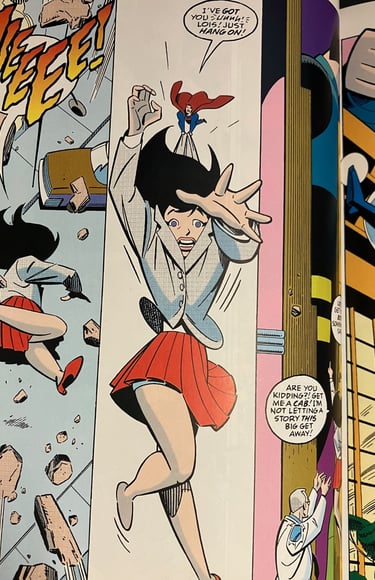

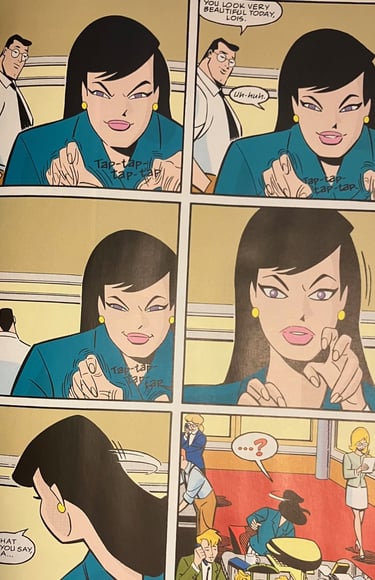

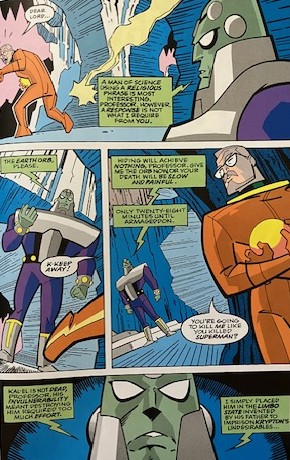

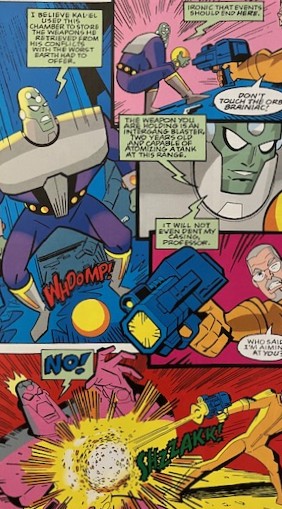

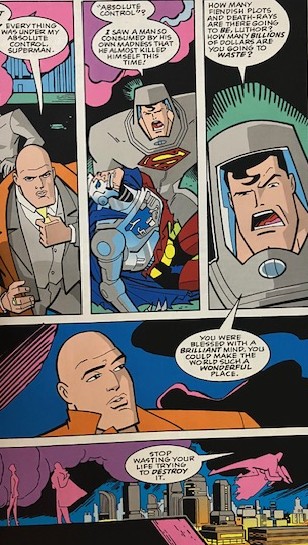

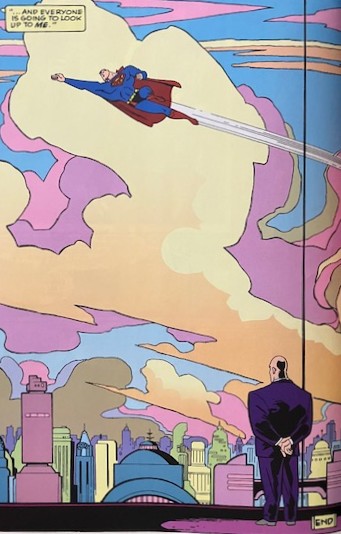

Superman Adventures, more than the show, gives the supporting cast a bit more depth, background--more to do. From Clark's sly flirt with Lois to Professor Hamilton taking on Brainiac by himself, the comic went where the cartoon never bothered.
The Compendium's Most Stupendous (with a few caveats and addendums)
The following is a selection of the compendium’s most noteworthy stories (per this critic’s modest analysis). Not all of these tales are necessarily perfect or utterly timeless, but they do all contain something creative, unique, or otherwise compelling. Whether one reads through the entire omnibus or not (924 pages!), these particular stories are worth one's attention.
So, for consideration…
Super Friends #25 (pg. 9): This particular tale isn’t even a Superman Adventures story—it’s actually issue #25 of The Batman Adventures featuring a “special” crossover between Bats and his mullet-donning associate…Superman! Although the story isn’t considered canon by any stretch (and isn’t anything brilliant, either), it’s still a fun “what-if” of what Superman, and Superman Adventures, could have been if this (now) trivial guest appearance had been used as the starting template.
Men of Steel #1 (pg. 42): Famed DC scribe Paul Dini sets Superman Adventures off with his one and only series contribution—a fun if simple tale pitting Superman against an actual “man-droid” of steel. It’s a snappy read that serves its purpose of quickly introducing readers to this particular incarnation of Superman’s world and denizens; within 22 pages, the script bounces from The Daily Planet staff to the Kent family farm to a final denouement with Lex Luthor. If not quite delectable by itself, the story instills all the necessary ingredients that would inform the excellent adventures to come.
Distant Thunder #3 (pg. 91): The second McCloud-penned story sees the gifted scribe already testing his creative talents with a tale featuring Brainiac, one of Supes’ most dangerous foes, using a host of mechanical cats to spy on the streets of Metropolis. It’s a very Silver Agey idea, but surpassing the whimsy are the poignant opening and closing scenes depicting a somber Superman gazing into the nighttime sky, witnessing the final light of his homeworld’s demise. Light only travels so fast, and for Superman, this means getting to observe the end of a world, but also…in a sense…his own origin and birth.
Eye to Eye #4 (pg. 115): If not a stellar tale by itself, there’s a potency in its fable-like simplicity as photographer Jimmy Olsen learns the true meaning of courage. Or, rather, what “being brave” is on a practical level. Sure, Superman is strong and bold and always saves the day…but he’s also nigh-invincible. Olsen, conversely, is just a fragile kid. Is getting the perfect shot worth getting shot himself…by a bad guy’s gun? Whether reckless or courageous, in Olsen’s line of work, running away doesn't make the paycheck...or gain the fame.
Dominoes #6 (pg. 163): Mxyzptlk, the mischievous imp from the 5th dimension, has both his fans and detractors. Some like his predictably unpredictable antics, some see him as a script-breaking gimmick. But there’s no arguing that he’s a difficult character to depict in any kind of profound way; despite his great cosmic powers, it’s tricky not to write him as anything but a zany cartoon character. But McCloud, in what could be his finest story in the collection, dodges all the normal traps and pitfalls to tell the perfect Mxyzptlk story. It’s mystery and whimsy caught in a temporal conundrum teetering on the edge of tragedy. And Burchett’s expressive artwork handily juggles that swirling swath, keeping the reader anchored but the drama intense as the panels bounce their characters around. Is Mxyzptlk villain, bystander, or hidden hero? So many questions in just 22 pages.
All Creatures Great and Small #7-8 (pg. 187): This rare two-parter actually links to the cartoon show's storyline “Blasts from the Past” in which two Kryptonian criminals, Mala and Jax-Ur, wreak havoc over the Earth. The comic shows the updated fate of these two fiends, and it’s a clever (if weird) one: via the tech of Dr. Hamilton’s Star Labs, the rudeful twosome are shrunk down to an action figure’s dimensions and placed in a red-light bathed terrarium of sorts. It’s more humane than the Phantom Zone, right? The villains will never escape, correct? But, of course, they do…with the added twist of a stupefied Supes getting shrunk himself in the process. It’s a fun if silly tale, with Burchett really selling the frantic action and skewed dimensions with fun-loving aplomb. The second part isn’t quite as good, rushing a conclusion that feels untidy. But, overall, this is a tale that exemplifies exactly what a comic called “Superman Adventures” should be all about.
Don’t Try This at Home #10 (pg. 259): In another silly but clever installment, this story sees the devious Toyman infiltrating peoples’ homes through a line of six-inch Superman figures. These docile toys are actually miniature robots that activate at night, whisking away people’s valuables, from wallets to jewelry. What really makes the story a keeper, however, is the ending: Thanks to believing the theory of a young girl (who suspects the true nature of the toys), Clark gets the front-page scoop on Lois. It’s a refreshing win for the oft-forgotten second half of Supes’ dual persona.
The War Within #11-12 (pg. 283): What if Superman was dying? What if the savior you accepted without question, took for granted without reflection, was now the man who needed help? "The War Within" sticks the Man of Steel with a slow-acting but deadly virus, one that is slowly eroding the Man of Steel’s powers until, eventually...to the point of death? It’s a sobering concept almost too heavy for the comic’s younger demographic, but McCloud handles the idea here with poignancy and grace. In truth, this is really a Lois Lane story—a tale of redemption for a reporter a little too cynical, a little too accustomed to being instantly rescued. The story continues for a second issue in which the (now) leading lady risks her own life in a race against time, globetrotting for a potential cure. A few more cursory elements, like Lex Luthor’s attempt at sabotaging the whole affair, feel a tad ham-fisted but add to the suspense. A feel-good story all around.
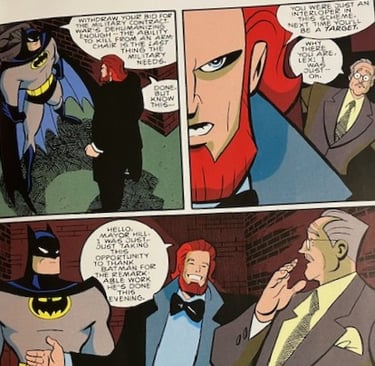

The compendium's first story is actually Batman Adventures #25, which borrows loosely from the mainstream comic's version of Lex Luthor and Superman (at least, for the time). As seen, this "Luthor" has a flowing mane of red hair (Superman, incidentally, sports a mullet).
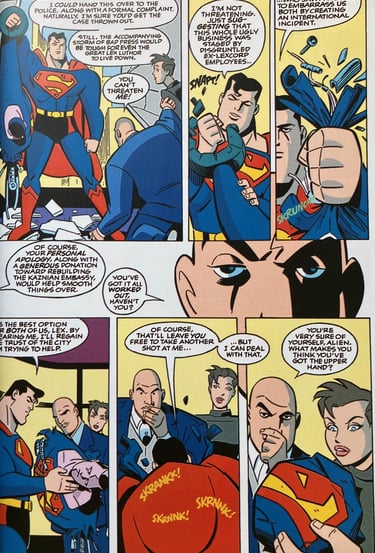

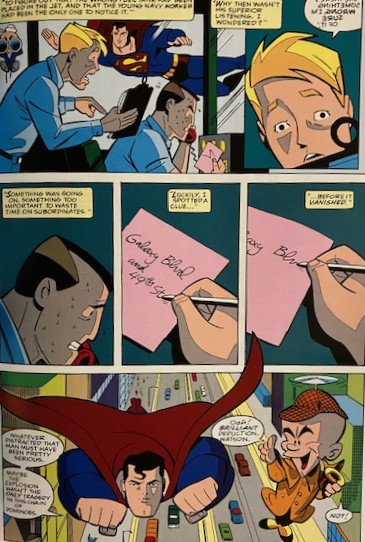

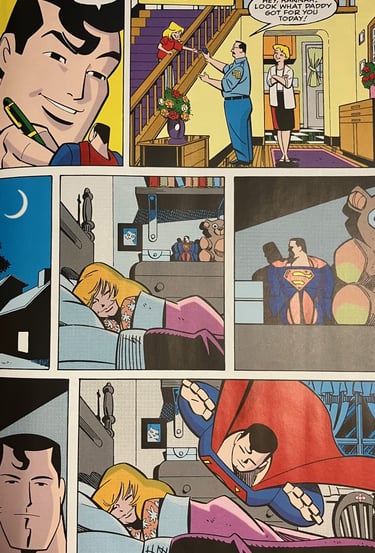

Issue #10 sees homes invaded by an army of tiny Supermen--tiny interlopers playing the ol' Trojan Horse until everyone is asleep. Once no one is watching, the little guys springs to action, pilfering wallets and jewelry and anything else they can grab.
The first issue is the only one which Paul Dini, famed DC writer and creator, scribed himself. It's not a brilliant attempt, but the story does its job in starting the series off.
McCloud's Mxyzptlk story is one of the imp's finest, telling a tale of mystery and entertainment in a single tightly-constructed issue.
Grand Slam #13 (pg. 331): As the final tale of McCloud’s titular twelve, "Grand Slam" ends the author’s run on a simple n’ silly ditty that feels altogether fitting. No deadly viruses or rogue AIs here; while attending a baseball game, Superman finds himself competing in a three-round contest against an alien invader as the stadium watches on. It’s very pulpy, goofy stuff…but again, it’s fun, and does what even the Animated Series failed to do: give Dr. Hamilton, Star Labs’ leading guru, a characterization that goes beyond being a deus ex machina in a lab coat. The issue also shows how to tell a Superman story that isn't overly self-serious. This is Superman being human, munching a hotdog with his two best friends and confidants, Lois and Hamilton.
Dark Planes Drifter #1 Annual (pg. 355): Annuals always struggle to match the quality and tone of the regular series. This is often due to their forced and ephemeral nature—they almost necessitate bringing in someone outside the normal team to get the story concocted and printed on time. And so is the case here: "Dark Planes Drifter" isn’t a particularly good or well-conceived story, but it does build on Superman/Clark Kent’s past in an interesting way. Just like Batman spent his early years being mentored by a variety of different gurus, mystics, and martial artists, Superman is shown doing the same. Already aware that, despite his super skin, he’s just as vulnerable to magical attacks as anyone else, a young Clark seeks the sage magician Zatara for some practical instruction. All that engrossing backstory, however, still can't quite redeem the otherwise trite tale of Superman fighting a vengeful demon.
Clark Kent, You’re Nobody! #16 (pg. 459): After Scott McCloud’s eclectic run, it remained unclear whether his successors would maintain the same vim and whim that made the comic so fun. Enter Mark Millar, a relative unknown at the time who did just that, capturing McCloud’s zany spirit while adding a touch of his own brand of real-world grit. Issue #16 is Millar’s first on the series, and it’s a good one: Mr. Mxyzptlk is back for another tale just as mysterious as his appearance back in issue #6. Poor Clark has lost his powers, and maybe, his mind…and he observes "Superman" flying around Metropolis doing all of his work. What’s the--? It’s not only a fun story, but by the conclusion, it reinforces why Superman is truly so super both within and without. Millar understands the hero; more than man, alien, brawn, or brain…he’s an American.
Superman vs. Lobo #1 Special (pg. 483): Despite being just an average tale overall, like "Dark Planes Drifter," it does offer a redeeming wrinkle: this time, in stopping the spread of a deadly virus, Superman himself becomes the carrier. Though immune to the disease, he’s now infectious to everyone else on Earth. So, with little recourse, the poor soul is forced to abandon his adopted planet. It’s a tragic, bittersweet premise that unfortunately devolves into, well, an uneasy alliance between himself and the wise-cracking scoundrel known as Lobo. Yep, despite the title, the two don’t fight so much as they quarrel while working (sort of) together. Ultimately, Superman gets cured…but there’s certainly a better story that could have been told based on that founding premise.
The Bodyguard of Steel #19 (pg. 571): Although not one of Millar’s best works, it begins with a great opener: Superman is trying to force his way into the White House’s Oval Office where the president waits defenseless. After prevailing over several waves of booby traps and militaristic defenses, the Man of Steel does just that, strolling into the room to make his grim but poignant point—the President is woefully susceptible to any kind of serious superhuman attack. The story’s second half never enjoys the same shock and bravado, unfortunately, with a rushed conclusion that tries to be clever but doesn’t really make much sense. Still, the early exchanges between Superman and General Hardcastle are excellent, displaying Millar’s more mature sensibilities. “Why don’t you like having me around the White House?” Superman asks, to which the general sneers, “Things might be different if you operated under the instructions of the U.S. Government, but you’ve always made it clear you won’t become involved in military matters, and that makes me highly suspicious.” And, in a sense, the general isn’t wrong. Superman, for all the good he does, is essentially a vigilante operating outside the law.
The Last Daughter of Argo #21 (pg. 618): Acting as a sort of sisterly, supplementary bookend to her debut in the Animated Series, issue #21 reintroduces the Maid of Might by toggling between flashbacks of her tragic past and her current struggle subduing a trio of heinous Kryptonians—Jax-Ur, Mala, and the newly revived General Zod. Her battle with the three fiends isn’t particularly memorable, but the glimpses back to her doomed family and home planet of Argo reveal a girl who’s extraordinary not because of her super strength, but the supreme horror she’s been able to bear. She’s lost everything. Is riddled with survivor's guilt and psychological pain. And yet, she carries on with a smile, aiming to live up to her cousin Superman’s name. It’s this examination of her character—of her resolve and inner fortitude—that makes this issue a worthy read.
Wargames #22/23 (pg. 673): Another winner by Millar, "War Games" is an engrossing two-parter that raises an obvious question—what if Brainiac, being the sentient AI (virus) that he is, took control of the world’s electronics, making them go haywire at will? That’s exactly what happens here except, rather than going after TVs and cellphones, the android invades the electrical grid. Takes over airspace by undermining air traffic control. Sends trains careening off their rails and space shuttles tumbling out of orbit. In short, Superman has a lot to do. And as Big Blue shoots from one disaster to the next, unable to pinpoint the greater power manipulating events, Brainiac executes its ultimate, diabolical plan. Nuclear annihilation…and the only one left to stop him isn’t the alien, but the former shock jock turned electric, Livewire. It’s an all-around solid story that gives the woman a fitting redemption while also granting characters like Lois Lane and Professor Hamilton moments of wisdom and heroism themselves—all told via the fine artwork of Aluir Amancio.
(Almost) the World’s Finest Team #25 pg. 745: One of Superman: The Animated Series’ greatest episodes is "Knight Time," a tale in which, after Batman mysteriously disappears, Supers teams up with an overwhelmed Robin to protect a lawless Gotham. This issue's story shares some of the former’s DNA, bringing in Superman to assist Batgirl while Batman is held captive by the scheming Mad Hatter. Unfortunately, this is the rare case where the cartoon trumps the book, with Millar’s take on the concept lacking the sheer fun and creativity of the cartoon’s more humorous approach. Still not a bad read, but its value really comes from it being a good point of comparison with the show.
Yesterday’s Man of Tomorrow #26 pg. 769: After already contriving one clever Mxyzptlk story, Millar writes another miracle in which the fifth-dimensional imp decides to travel back to the Man of Tomorrow's childhood. And, indeed, he succeeds, convincing a young Clark Kent that, unless he leaves the Earth, he’s fated to become the world’s greatest tyrant. Of course, duping a kid isn’t the same—doesn't earn the same cred—as prevailing over the distinguished and titular Man of Steel...a reality even Mxy is forced to admit. The status quo is thus reestablished by the issue’s conclusion, but the overall story is still a fun what-if while it lasts, even if it never surpasses the earlier Mxy-verse tales.
How Much Can One Man Hate? #27 pg. 793: Here, Millar explores another question: What if Superman finally met his match…not in a maniacal villain, but in another do-gooder? Or, more simply, what does a Superman do once he’s been otherwise replaced and left with a relatively open schedule? It’s a fun idea that gets somewhat curtailed by the limitations of its 22 pages; a double-issue, or even a full six-issue run, would have offered the needed space and freedom to properly present the sophisticated story of a paragon among men now rendered passe. Redundant. Mundane. Even trivial. Instead, it’s actually Lex Luthor who commands the most introspection; a chilling flashback into the man's childhood shows a soul already mad with ambition. What Superman has been freely given, Luthor would deign to take. The Man of Steel vs. the Man of Steal, indeed.
Jimmy Olsen Versus Darkseid #28 pg. 817: The notion of the “body swap” has become a bit of a trope over the last several decades, with plenty of movies, cartoons, and comics playing with what’s apparently an irresistible idea. Everything from Jimmy Neutron to Futurama to even Lizzie McGuire have experimented with the switcheroo—and Superman Adventures was hardly immune. Hence this ish, which sees Superman’s soul/consciousness swapped with Jimmy Olsen, leaving the Man of Steel trapped as the red-haired lad. It’s an undeniably goofy issue that, truth be told, could have been even better as a two-parter. Or, perhaps, a Mxyzptlk tale.
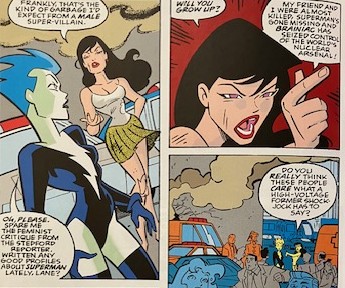

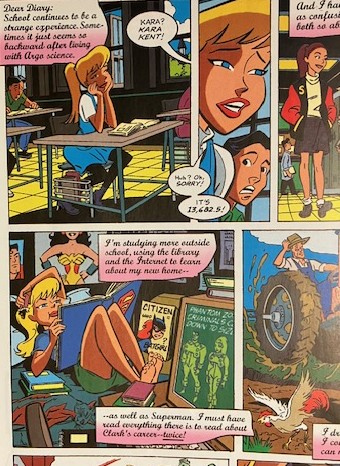

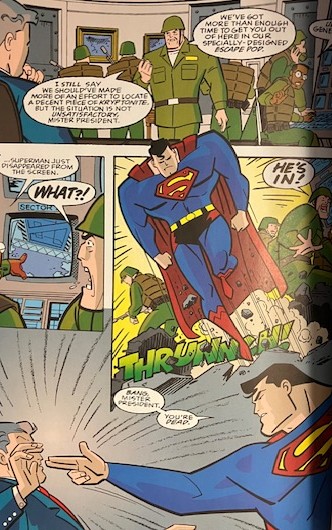


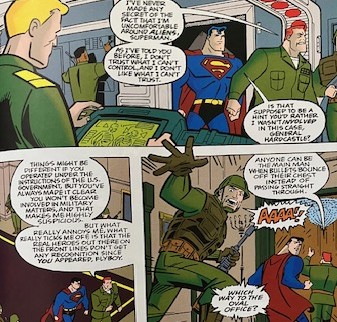
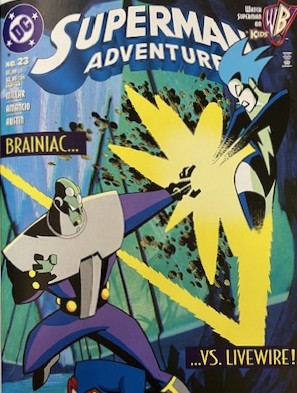

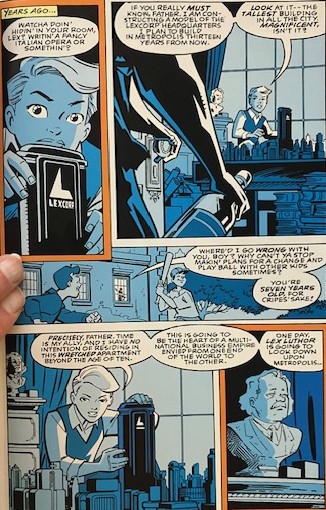

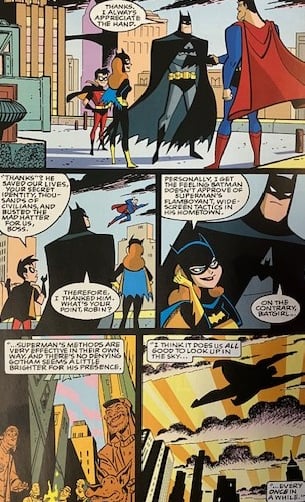

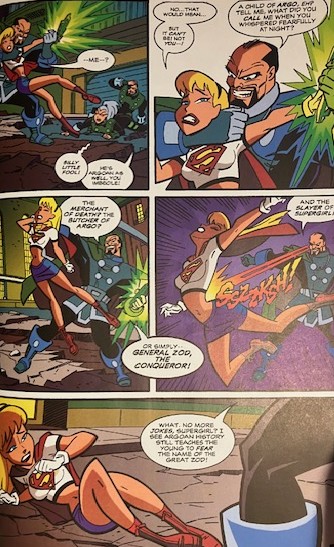

The Supergirl story provides a more elaborate accounting of her tragic past than what the animated series bothered to detail. It's told in a double-sized issue that almost could have been the first issue to her own series.
"The Bodyguard of Steel" raises some interesting debates regarding Superman's role in the American government; is he a stand-alone agent, or subordinate to the president and the whims of the nation?
Superman has another crossover with Batman, but the story can't quite match the TV show's brilliant Knight Time episode.
Livewire plays a pivotal role in this excellent Brainiac tale. Here, she has a "philosophical" discussion with Lois.
In "How Much Can One Man Hate," a compelling glimpse into Luthor's past is provided. It shows that, even as a child, Lex was a scheming megalomaniac.
In Conclusion: The Man of Steel Needs Your Super Support!
Superman Adventures: Compendium One closes out with World’s Finest, an adaptation of the Superman: The Animated Series three-episode storyline in which Supes and Batman face-off against Luthor and the Joker. The adaption is fine…but, perhaps inevitably, skips over the smaller, more nuanced moments of its animated counterpart. Finally, the story “Dimension of the Dark Shadows” is given a never-before reprint. The tale, so a brief introduction explains, was a promotional tie-in for the 1999 Nintendo 64 game Superman: The New Adventures (a game better known by most as the infamous Superman 64). It’s not a particularly memorable story, but as a piece of strange, forgotten esoterica, the inclusion itself is commendable…especially in light of the collection’s dearth of essays, interviews, reminisces, or anything otherwise informative. Considering the talent latent to these pages, DC’s apathetic regard to the overall book is inexplicable. Dastardly. Villainous! And sadly, exactly what Superman fans have come to expect over the years.
Superman, despite being the first and the best, just can’t get any respect.
So please, buy his book.—D


Contact: lostnostalgiaproductions@gmail.com
Website: www.lostnostalgia.com
Like what we're doing? Please consider throwing us a dollar into our Patreon page's tip jar!


